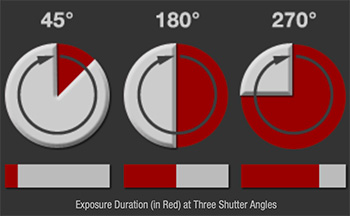Tip #534: What is Shutter Angle?
… for Random Weirdness
Tip #534: What is Shutter Angle?
Larry Jordan – LarryJordan.com
Motion blur increases as shutter angle increases.


This is an excerpt from RED.com. The advent of digital cinematography has opened up new creative possibilities for how motion is captured. This article explores the influence of shutter angle along with how it can be used as a creative tool for accomplishing one’s artistic goals.
CONCEPT
The “shutter angle” is a useful way of describing the shutter speed relative to the frame rate. This term is a conceptual relic of rotary shutters, where a disc with an angled opening would spin and let in light once per revolution to expose each frame. The larger the angle, the slower the shutter speed, all the way up to the limit of 360°, where the shutter speed could become as slow as the frame rate. At the other extreme, the shutter speed can be made arbitrarily fast by decreasing the angle.
APPEARANCE
By far the most common setting for cinema has been a shutter angle near 180°, which equates to a shutter speed near 1/48 of a second at 24 fps. Any larger, and motion appears more smeared since the end of blur in one frame extends closer to the start of blur in the next frame. Any smaller, and the motion appears more stuttered and disjointed since the blur gap increases, causing frames to become more like discrete images.
DISCUSSION
Although many film cameras were capable of only certain shutter angle ranges, digital cameras provide many exciting new possibilities. Just as focal length and aperture have been used as creative tools for controlling sense of scale and depth of field, shutter angle has the potential to do the same for motion.
The optimal setting will ultimately depend on other factors, such as the speed of subject movement within the frame, or the creative intent of the cinematographer. For example, one might wish to use a larger shutter angle to increase the exposure time and reduce image noise in low-light, or to give the impression of softer and more fluid motion. Alternatively, with fast action one might place more importance on depicting crisp details in each frame by using a smaller shutter angle.
Another consideration might be the film era one desires to emulate. Shutter angles much less than 180° more closely mimic the style of old 1950’s newsreels, for example, and a shutter angle of 180° will typically give footage a standard cinematic style.
EXTRA CREDIT
Here’s a link from Red.com to learn more.


An iOS glitch meant that I could only give this 5-star tip a 2-star rating… so I wanted so say – excellent tip! Very clear and concise explanation of this concept.
Laurel:
Thanks for your note. I always learn something writing these.
Larry